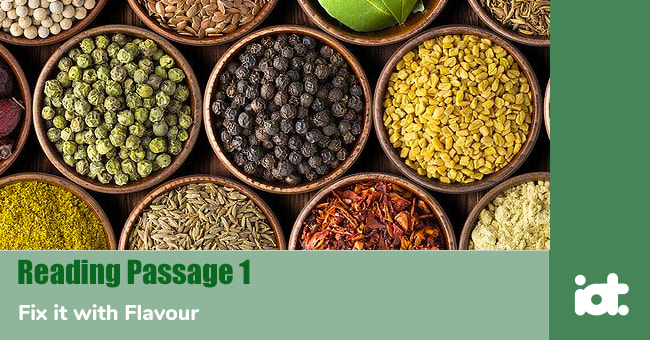
IELTS Practice Test Volume 6
- Published on: 05 Sep 2019
- Tests taken: 74,950
Answer Keys:
Part 1: Question 1 - 13
- 1 G
- 2 E
- 3 C
- 4 A
- 5 muddled
- 6 arthritis
- 7 vitamin C
- 8 pleasure
- 9 NOT GIVEN
- 10 FALSE
- 11 TRUE
- 12 TRUE
- 13 NOT GIVEN
- 1 G
- 2 E
- 3 C
- 4 A
- 5 muddled
- 6 arthritis
- 7 vitamin C
- 8 pleasure
- 9 NOT GIVEN
- 10 FALSE
- 11 TRUE
- 12 TRUE
- 13 NOT GIVEN
Part 2: Question 14 - 26
- 14 D
- 15 F
- 16 G
- 17 C
- 18 22 A,C,D,E,F
- 23 B
- 24 A
- 25 A,B
- 26 A,D
- 14 D
- 15 F
- 16 G
- 17 C
- 18 22 A,C,D,E,F
- 23 B
- 24 A
- 25 A,B
- 26 A,D
Leaderboard:
| # | User | Score | Time | |
|---|---|---|---|---|
| quan do |  | 9.0 | 23:34 | |
| Anindi K |  | 9.0 | 24:10 | |
| Son Vuong |  | 9.0 | 27:05 | |
| 4 | Nair Chithra Harinarayanan |  | 9.0 | 29:36 |
| 5 | Lamar Alshangeety |  | 9.0 | 30:30 |
| 6 | Anjali Mende |  | 9.0 | 31:57 |
| 7 | Subhashis Mishra |  | 9.0 | 32:17 |
| 8 | Gitika Verma |  | 9.0 | 32:42 |
| 9 | Nhi Ho |  | 9.0 | 32:50 |
| 10 | Thái Nguyễn Anh |  | 9.0 | 34:47 |
Review & Explanations:
Questions 1-4
The text has 9 paragraphs (A -I).
Which paragraph contains each of the following pieces of information?
1 The reason that turmeric is yellow
2 How turmeric is used by Indians
3 A medieval cure for stomach aches
4 The method Gabriele Dionisi uses to solve stomach aches
- 1 Answer: G
Keywords in Questions
Similar words in Passage
Q1: The reason that turmeric is yellow
G. Studies at the Indian Institute of Science, in Bangalore, suggest that curcumin, the chemical that gives turmeric its yellow colour.
Note:
Q1 is about the reason why turmeric is yellow. We can read about turmeric in paragraph D, E and G. But considering every details in the question and in the paragraph G, we can know that “the chemical that gives turmeric its yellow color is curcumin”, it means that the yellow of turmeric is given by “curcumin”.
Therefore, for that reason, the answer is G
- 2 Answer: E
Keywords in Questions
Similar words in Passage
Q2: How turmeric is used by Indians
E. Turmeric is used in Indian homes as a first-aid treatment. For example, if you had a small cut on your finger, you'd run it under the tap and then dust the wound with turmeric. It is also supposed to be a cure for arthritis, and scientists are now researching its potential ability to suppress the growth of cancer cells.
Note:
We can read in paragraph E that “turmeric is used in Indian homes as a first-aid treatment, it refers to the use of turmeric in Indian homes or how turmeric is used by Indians. All keywords in Q2 are mention in paragraph E.
For that reason, the answer is E
- 3 Answer: C
Keywords in Questions
Similar words in Passage
Q3: A medieval cure for stomach aches
C. Ginger was held to be good for stomach upsets, and it is now known to have anti-nausea properties.
Note
“Stomach aches” and “stomach upsets” refer to the same meaning in this case.
In addition, only in paragraph C mentioned stomach and suggest “ginger was held to be good for stomach upsets”, it means they suggest “ginger is a medieval cure for stomachaches”
So the answer is C
- 4 Answer: A
Keywords in Questions
Similar words in Passage
Q4: The method Gabriele Dionisi uses to solve stomach aches
For some unfathomable reason, he sometimes has problems with his guts. Then he makes himself a hot cup of camomile tea with honey and half a spoonful of chilli flakes. "It’s an old Italian recipe," he says. "Ms- grandmother taught me to make it. It’s very good for the digestion.”
Note:
We can easily see only paragraph A mention “Gabriele Dionisi”. We can guess the answer for Q4 may be A.
In addition, paragraph A shows the recipe made by Gabriele Dionisi to be a method to solve problems with his guts.
“His guts” relates to “his stomachaches” in this case.
For that reason, the answer is A
Questions 5-8
Complete the following sentences using NO MORE THAN TWO WORDS from the text for each gap.
The article refers to medieval herbalists as 5 because they didn’t always use herbs properly.
The article provides no support for the suggestion that turmeric can help to deal with 6 , though this is being investigated.
A single chilli provides more 7 than a person needs in a day.
Eating chillies creates a feeling of 8 thanks to the release of endorphins.
- 5 Answer: muddled
Keywords in Questions
Similar words in Passage
Q5: The article refers to medieval herbalists as …. because they didn’t always use herbs properly.
… Unfortunately, those muddled medieval medics also believed that ginger was a cure for the Black Death - it isn’t - and that eating borage would give you courage, just because the words rhymed.
Note: Follow paragraph C, we can read that medieval herbalists believed “eating borage would give you courage, because the words rhymed”, that means they didn’t use herbs properly.
So, the article refers them as muddled.
For that reason, the answer is muddled.
- 6 Answer: arthritis
Keywords in Questions
Similar words in Passage
Q6: The article provides no support for the suggestion that turmeric can help to deal with …, though this is being investigated.
It is also supposed to be a cure for arthritis, and scientists are now researching its potential ability to suppress the growth of cancer cells.
Note
Follow the paragraph E, we can read “turmeric is supposed to be a cure for arthritis”, it means that “it can help to deal with arthritis”
And “search” and “investigate” refer to the same meaning in this case.
Therefore, the answer should be arthritis.
- 7 Answer: vitamin C
Keywords in Questions
Similar words in Passage
Q7: A single chilli provides more …. than a person needs in a day.
One chilli contains 100mg of vitamin C more than the daily recommended amount, and capsaicin, the chemical in chillies that gives them heat, is also a natural decongestant.
Note
All keywords are mentioned with the same meaning in Q7.
“A single chili” and “one chili” refer to the same thing in this case.
“needs in a day” and “ daily recommended amount” have the same meaning in this context.
From paragraph, “one chili contains 100mg of vitamin C more than the daily recommended amount”, it means that one chili provides more vitamin C than a person needs in a day.
Therefore, we can easily guess the answer for Q7 should be “vitamin C”
- 8 Answer: pleasure
Keywords in Questions
Similar words in Passage
Q8. Eating chillies creates a feeling of … thanks to the release of endorphins.
The pleasure of chillies comes from the pain of eating them. Literally, the burning sensation in the mouth triggers the release of endorphins, an opiate-like painkilling chemical, in the brain.
Note
Follow paragraph I, we can see that “the burning sensation in the mouth triggers the release of endorphins”, and “the pleasure of chilies comes from the pain of eating them (chilies)”.
We can understand that eating chilies create the feeling of pleasure because of the release of endorphins.
For that reason, we choose “pleasure” to be the correct answer for Q8.
Questions 9-13
Do the following statements agree with the information given in Reading Passage 1?
In boxes 9 -13 on your answer sheet, write
| TRUE | if the statement agrees with the information |
| FALSE | if the statement contradicts the information |
| NOT GIVEN | If there is no information on this |
9 Cloves are used to make aspirin.
10 Turmeric is not used in Indian cooking because of its taste.
11 Zyflamend can kill cancer cells.
12 Chillies help prevent colds because they contain capsaicin.
13 Signora Dionisi taught her favourite grandson many traditional Italian recipes.
- 9 Answer: NOT GIVEN
Keywords in Questions
Similar words in Passage
Q9. Cloves are used to make aspirin.
For example, they used to pound up cloves to extract the oil, which was used to treat toothache. Sensible move: modern scientists know that cloves contain eugenol, a chemical which is an effective local an aesthetic. Cloves also contain salicylic acid, the basis of aspirin.
Note
Follow paragraph B, we can read that “Cloves also contain salicylic acid, the basic of aspirin”, but we cannot find any information that cloves are used to make aspirin or not.
Therefore, the answer for Q9 is “Not Given”
- 10 Answer: FALSE
Keywords in Questions
Similar words in Passage
Q10. Turmeric is not used in Indian cooking because of its taste.
The Indian chef’s favourite medical spice is turmeric, the yellow ingredient used in almost all Indian cookery. Turmeric is an antiseptic and disinfectant, and it is used widely not so much for its taste but for its antibacterial properties.
Note
Follow paragraph D, we can easily read that “the Indian chef’s favorite medical spice is turmeric…”, it means that turmeric is used in Indian cooking.
This information is contradicted with statement in Q10. Therefore, the answer for Q10 is “False”
- 11 Answer: TRUE
Keywords in Questions
Similar words in Passage
Q11. Zyflamend can kill cancer cells.
Zyflamend has shown an ability to reduce prostate cancer cell proliferation by as much as 78% and induce cancer cell death.
Note
Follow paragraph F, we can read “Zyflamend has shown an ability to reduce prostate cancer cell proliferation”, it means that Zyflamend can kill cancer cells.
The answer for Q11 is “True”
- 12 Answer: TRUE
Keywords in Questions
Similar words in Passage
Q12. Chillies help prevent colds because they contain capsaicin.
Also, chilli contains twice as much vitamin C as an orange, and it really can help to protect the body from colds and flu. One chilli contains 100mg of vitamin C more than the daily recommended amount, and capsaicin, the chemical in chillies that gives them heat, is also a natural decongestant.
Note
Follow paragraph H, we can understand that “Chilli can help to protect the body from colds and flu because they contain vitamin C, capsaicin
The information in paragraph H refer to the same meaning with Q12. Therefore, the answer for Q12 is “True”
- 13 Answer: NOT GIVEN
Reading Passage 1
You should spend about 20 minutes on Questions 1 - 13, which are based on Reading Passage 1 below.

Fix it with Flavour
A. Gabriele Dionisi, a '38-year-old Italian computer wizard living in London, is a true individualist when it comes to food. He has been known to live for days on dry toast and mashed potato. He’s also very fond of tinned mackerel with biscuits, washed down with, say, an apple-and-tomato milkshake. For some unfathomable reason, he sometimes has problems with his guts. Then he makes himself a hot cup of camomile tea with honey and half a spoonful of chilli flakes. "It’s an old Italian recipe," he says. "Ms- grandmother taught me to make it. It’s very good for the digestion.”
B. Spices such as chilli have been used for medicinal purposes in Europe for centuries. Medieval herbalists believed that spices could be used to treat a range of pains, diseases, and ailments. Sometimes they got it right; sometimes they were way off the end of the spice rack. For example, they used to pound up cloves to extract the oil, which was used to treat toothache. Sensible move: modern scientists know that cloves contain eugenol, a chemical which is an effective local anaesthetic. Cloves also contain salicylic acid, the basis of aspirin.
C. Ginger was held to be good for stomach upsets, and it is now known to have anti-nausea properties. It is also believed to have a painkilling effect, which is being studied at the University of Arizona. Unfortunately, those muddled medieval medics also believed that ginger was a cure for the Black Death - it isn’t - and that eating borage would give you courage, just because the words rhymed.
D. Doctors in India have long used spices as medicines. They understood that spices could be used as remedies. Their motto was: Let food be thy medicine. The Indian chef’s favourite medical spice is turmeric, the yellow ingredient used in almost all Indian cookery. Turmeric is an antiseptic and disinfectant, and it is used widely not so much for its taste but for its antibacterial properties.
E. Turmeric is used in Indian homes as a first-aid treatment. For example, if you had a small cut on your finger, you'd run it under the tap and then dust the wound with turmeric. It is also supposed to be a cure for arthritis, and scientists are now researching its potential ability to suppress the growth of cancer cells.
F. In 2002, staff at the oncology department of Leicester University noticed that of 500 patients with colon cancer, only two were Asian, despile the fact that 20 per cent of the population in Leicester is Asian. The scientists believed this was due to their spicy diet. And, in America, researchers at the Columbia University College of Physicians and Surgeons are investigating Zyflamend, a herbal treatment for arthritis, which contains turmeric and ginger. Zyflamend has shown an ability to reduce prostate cancer cell proliferation by as much as 78% and induce cancer cell death.
G. Studies at the Indian Institute of Science, in Bangalore, suggest that curcumin, the chemical that gives turmeric its yellow colour, might also help to treat malaria. Mice were infected with the malaria parasite Plasmodium berghei and given five daily doses orally. After 20 days, a third of the treated mice were alive, whereas the untreated animals all died by day 13.
H. If you want to know what chillies do to the body, cut open a fresh chilli and hold it on the back of your hand for 15 or 20 minutes. It will make the hand red and sore. It you eat it in excess, it can give you gastric problems. However, in small doses, chilli can aid digestion. Chilli contains vitamins A and E and is a good source of potassium, beta carotene, and folic acid. Also, chilli contains twice as much vitamin C as an orange, and it really can help to protect the body from colds and flu. One chilli contains 100mg of vitamin C more than the daily recommended amount, and capsaicin, the chemical in chillies that gives them heat, is also a natural decongestant.
I. The pleasure of chillies comes from the pain of eating them. Literally, the burning sensation in the mouth triggers the release of endorphins, an opiate-like painkilling chemical, in the brain. This makes you feel good; so good, in fact, that it is possible to become a chilli junkie. In the light of this, perhaps the late Signora Dionisi should have taught her favourite grandson how lo make something oilier than chilli camomile tea.





